
The Enchanted Highway is a collection of the world's largest scrap metal sculptures [1] constructed by Gary Greff at intervals along a 32-mile (51 km) stretch of a two-lane highway in the southwestern part of the U.S. state of North Dakota.

The Enchanted Highway is a collection of the world's largest scrap metal sculptures [1] constructed by Gary Greff at intervals along a 32-mile (51 km) stretch of a two-lane highway in the southwestern part of the U.S. state of North Dakota.
The road has no highway number, although its northern portion is 100+1⁄2th Avenue SW (counting from Bismarck, which is 85 miles [137 km] to the east). The Enchanted Highway extends north from Regent to the Gladstone exit on Interstate 94 east of Dickinson. Each sculpture has a developed pull-out and several have picnic shelters; the highway passes through scenic farm country with intermittent buttes. Geese in Flight is visible from I-94, standing 110 feet tall and 150 feet wide. [2] In 2002, it was recognized as the world's largest scrap metal sculpture by the Guinness Book of World Records . [3]
Local artist Gary Greff conceived of the project and began building it in 1989, and continues to maintain the sculptures. [4] He took inspiration from local wildlife and historical figures, including Theodore Roosevelt. [5] Greff's intention was to revive his hometown of Regent, after decades of population and economic decline. [4] [2] In 2012, Greff opened a motel, The Enchanted Castle, in Regent, continuing the theme of the Enchanted Highway. [6] The State of North Dakota provided $75,000 in its 2019-2020 budget to assist Greff in maintaining the sculptures; prior to that year, he had used his own money and donations to pay for upkeep. [4] [5] The highway attracts approximately 6,000 tourist cars per year. [2]
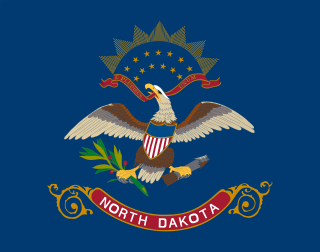
North Dakota is a landlocked U.S. state in the Upper Midwest, named after the indigenous Dakota Sioux. It is bordered by the Canadian provinces of Saskatchewan and Manitoba to the north and by the U.S. states of Minnesota to the east, South Dakota to the south, and Montana to the west. North Dakota is part of the Great Plains region, characterized by broad prairies, steppe, temperate savanna, badlands, and farmland. North Dakota is the 19th-largest state by area, but with a population of just under 800,000, it is the fourth-least populous and fourth-most sparsely populated. The state capital is Bismarck while the most populous city is Fargo, which accounts for nearly a fifth of the state's population; both cities are among the fastest-growing in the U.S., although half of all residents live in rural areas.

South Dakota is a landlocked state in the North Central region of the United States. It is also part of the Great Plains. South Dakota is named after the Dakota Sioux tribe, which comprises a large portion of the population — with nine reservations currently in the state — and has historically dominated the territory. South Dakota is the 17th-largest by area, but the fifth-least populous, and the fifth-least densely populated of the 50 United States. Pierre is the state capital, and Sioux Falls, with a population of about 213,900, is South Dakota's most populous city. The state is bisected by the Missouri River, dividing South Dakota into two geographically and socially distinct halves, known to residents as "East River" and "West River". South Dakota is bordered by North Dakota to the north, Minnesota to the east, Iowa to the southeast, Nebraska to the south, Wyoming to the west, and Montana to the northwest.

Bismarck is the capital of the U.S. state of North Dakota and the county seat of Burleigh County. It is the state's second-most populous city, after Fargo. The population was 73,622 at the 2020 census, and was estimated to be 75,092 in 2023, while its metropolitan population was 133,626. In 2020, Forbes magazine ranked Bismarck as the seventh fastest-growing small city in the United States.
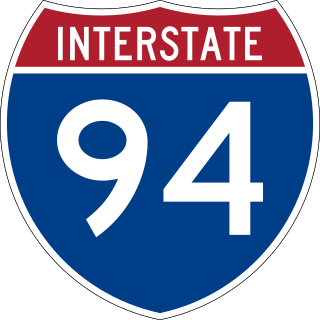
Interstate 94 (I-94) is an east–west Interstate Highway connecting the Great Lakes and northern Great Plains regions of the United States. Its western terminus is just east of Billings, Montana, at a junction with I-90; its eastern terminus is in Port Huron, Michigan, where it meets with I-69 and crosses the Blue Water Bridge into Sarnia, Ontario, Canada, where the route becomes Ontario Highway 402. It thus lies along the primary overland route from Seattle to Toronto and is the only east–west Interstate Highway to have a direct connection to Canada.

Ward County is a county in the U.S. state of North Dakota. As of the 2020 census, the population was 69,919, making it the fourth most populous county in North Dakota. Its county seat is Minot. Ward County is part of the Minot, ND Micropolitan Statistical Area.
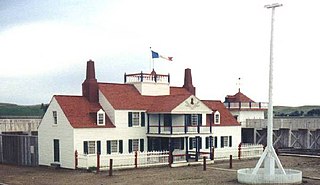
McKenzie County is a county in the U.S. state of North Dakota. As of the 2020 census, the population was 14,704. Its county seat is Watford City.
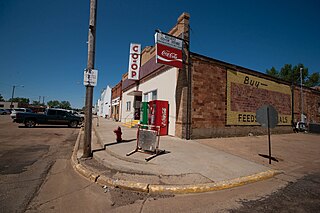
Regent is a city in Hettinger County, North Dakota, United States. The population was 170 at the 2020 census.

A roadside attraction is a feature along the side of a road meant to attract tourists. In general, these are places one might stop on the way to somewhere, rather than being a destination. They are frequently advertised with billboards. The modern tourist-oriented highway attraction originated as a U.S. and Canadian phenomenon in the 1940s to 1960s, and subsequently caught on in Australia. Elsewhere, except Antarctica, similar items are placed on roundabouts and traffic islands in crowded cities.
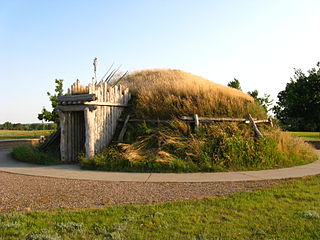
The Knife River Indian Villages National Historic Site, which was established in 1974, preserves the historic and archaeological remnants of bands of Hidatsa, Northern Plains Indians, in North Dakota. This area was a major trading and agricultural area. Three villages were known to occupy the Knife area. In general, these three villages are known as Hidatsa villages. Broken down, the individual villages are Awatixa Xi'e, Awatixa and Big Hidatsa village. Awatixa Xi'e is believed to be the oldest village of the three. The Big Hidatsa village was established around 1600.

Interstate 94 (I-94) runs east–west for 352.4 miles (567.1 km) through the southern half of the US state of North Dakota, from the Montana state line east to the Red River at Fargo. The route generally follows the route of the Northern Pacific Railway.
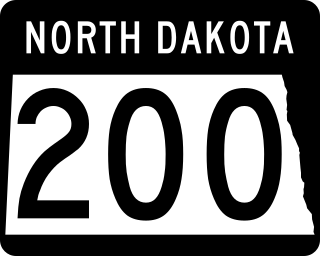
North Dakota Highway 200 (ND 200) is a major east–west state highway in North Dakota, United States. It runs from Minnesota State Highway 200 at the Minnesota border near Halstad, Minnesota to Montana Highway 200 near Fairview, Montana. At nearly 416 miles (669 km), it is the longest state highway in North Dakota.
Porter Sculpture Park is located just off Interstate 90 in Montrose, South Dakota. It is on the South Dakota Drift Prairie, only 1/4 of a mile off of the interstate. There are over 60 sculptures in the Park which is situated on 10 acres of tall grass prairie.. Many of the sculptures, in the style of industrial art, were made with scrap metal, old farm equipment, or railroad tie plates. The largest sculpture in the park is a 60-foot-tall (18 m) bull head. This sculpture took three years to build, weighs 25 tons, and is equal in size to the heads of Mount Rushmore. Every sculpture in the park was made by Sculptor Wayne Porter. The Park is open May 15 - October 15 annually. Admission is $10 per adult, $5 ages 13–17, and free for ages 12 and under. History of the Artist and Porter Sculpture Park Artist: Wayne Porter is a sculptor who grew up in rural South Dakota and learned to weld as a child in his father's blacksmith shop. He has never taken an art class. He made his first small sculpture at the age of 10. After graduating from South Dakota State University in Brookings with degrees in political science and history, he was a sheep rancher for a few years and worked on sculptures when he had free time. Art: Many of his sculptures are large and most of the early pieces are made from junk/found metal, including the bumper of an old family car, an antique water heater from the local dump, and pieces of old farm machinery. He has written and displays poetry that accompany many of the sculptures. The sculptures are majestic, whimsical, thought provoking, and readily display the influences of the South Dakota prairies he grew up on. They reflect his quick wit, humor, and diverse influences. Sculpture Park: Wayne Porter opened the park in the fall of 2000. He had been ranching and creating sculptures for several years and the art piled up outside of his Dad's blacksmith shop. Over time, cars and buses would come off the highway that runs through the small town of St. Lawrence, SD to see his sculptures and want to pay him. He realized that sheep ranching is really hard work and he could make a living doing what he loved. He looked for land near Interstate 90 to have better access for tourists and was able to move his sculptures to the current location and open Porter Sculpture Park. The artist continues to make new art in the blacksmith shop where he learned to weld during the offseason and moves the sculptures to the park when they are finished. Prairie: Wayne has been working to restore the prairie to a native South Dakota tall grass prairie. His farmer friend's cows are in the park in the spring before the park opens to give birth to their calves and eat the grass. Healthy prairies require this or an annual burn. It took a few years to see native flowers and grasses returning, and the restoration continues to be a work in progress.

South Dakota is a state located in the north-central United States. It is usually considered to be in the Midwestern region of the country. The state can generally be divided into three geographic regions: eastern South Dakota, western South Dakota, and the Black Hills. Eastern South Dakota is lower in elevation and higher in precipitation than the western part of the state, and the Black Hills are a low, isolated mountain group in the southwestern corner of the state. Smaller sub-regions in the state include the Coteau des Prairies, Missouri Coteau, James River Valley, and the Dissected Till Plains. Geologic formations in South Dakota range in age from two billion-year-old Precambrian granite in the Black Hills to glacial till deposited over the last few million years. South Dakota is the 17th-largest state in the country.

The Theodore Roosevelt Expressway, is made up of several existing highways between Rapid City, South Dakota and the Port of Raymond between Saskatchewan and Montana. It is the northern third of the Ports-to-Plains Alliance. The corridor is approximately 445 miles (716 km) long with the majority of the highway two lanes. Congress designated the route as one of 80 National Highway System High-Priority Corridors in 2005 by the Intermodal Surface Transportation Efficiency Act. The designation did not create new design standards or create new eligibility for any additional federal funding.

North Dakota Highway 21 (ND 21) is an east-west highway in North Dakota. The eastern terminus is at ND 6 about 5 miles (8.0 km) north of Breien and the western terminus is at U.S. Route 85 (US 85) about 5 miles (8.0 km) east-northeast of Amidon. The highway is known for the large number of abandonments located along it.

Mighty Og was a roadside attraction consisting of a 36-foot (11 m) high sculpture of a gorilla from the waist up. It originally graced a billboard promoting Rawhide City, a tourist attraction in Mandan, North Dakota.
Elmer Paul Petersen was an American sculptor who worked in metal. His most prominent artwork is the World's Largest Buffalo in Jamestown, North Dakota. Petersen lived and worked in Galesville, Wisconsin. Much of his art is publicly displayed around La Crosse, Wisconsin, where he led the Downtown La Crosse Sculpture Project Committee. The La Crosse Tribune called Petersen "one of the premier sculptors in the Coulee Region" and "instrumental in getting public sculpture scattered throughout downtown" La Crosse. He has worked significantly with welding, including that of found metal objects, and often sculpted in cast bronze.

The 2020 United States House of Representatives election in North Dakota was held on November 3, 2020, to elect the U.S. representative from North Dakota's at-large congressional district. The election coincided with the 2020 U.S. presidential election, as well as other elections to the House of Representatives, elections to the United States Senate and various state and local elections.

John Lopez is an American sculptor known for his life-size hybrid metal sculptures made out of discarded farm equipment and bronze. He is equally known for his 12 life-size presidential monuments made for The City of Presidents in Rapid City, South Dakota. Some of the presidents include John F. Kennedy and John Jr., Grant, Carter, Harrison, Coolidge, T. Roosevelt, and Garfield. He lives in Lemmon, South Dakota.